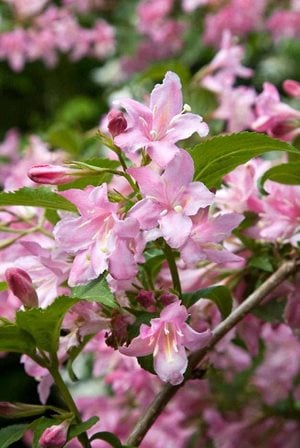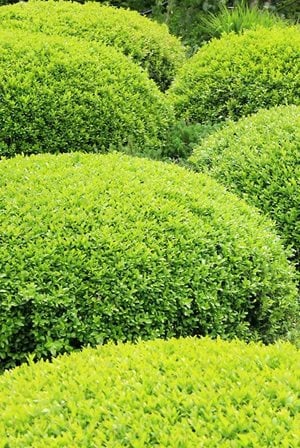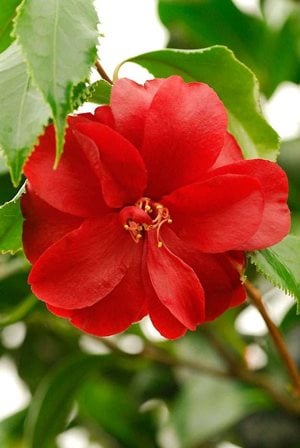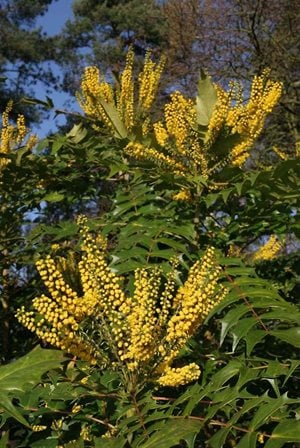Once you know the principles of pruning it is easier than you think and, if you prune shrubs at the right time of year, it will really improve their performance
Deciduous trees and shrubs
In winter, deciduous plants shed leaves and send food reserves to their roots. If you prune in winter or spring they then have ample resources to regrow and balance their roots with their top growth. If you prune in summer then you are removing food reserves in the green leaves.
Spring pruning (before flowering)
_WSYD0007071.jpg?width=300&height=447) If your plants flower from July - October and are deciduous, then you can prune these plants in spring. Food reserves from the roots will soon send out new shoots which then tend to flower at the ends of the new growth.
If your plants flower from July - October and are deciduous, then you can prune these plants in spring. Food reserves from the roots will soon send out new shoots which then tend to flower at the ends of the new growth.
Prune last year’s growth to just two or three buds above healthy thick stems to provide a good framework for the new growth.
Plants suitable for this pruning:
More details on pruning summer-flowering shrubs.
Summer pruning (after flowering)

If your plants flower from November - June and are deciduous, then you can prune these plants immediately after flowering. This will remove much of the food reserves in the green leaves and prevent the strong and flowerless growth you would get from spring pruning. Flower buds are not formed on the new growth but on existing branches.
Prune flowered stems back to a strong upright shoot as low as possible. Older branches which flower weakly are best removed. Remove one stem in three e.g. a shrub with five stems would have the two largest and oldest shoots removed down to 25-45cm (10-18in) above the soil.
Plants suitable for this pruning:
More details on pruning early-flowering shrubs.
Evergreen trees and shrubs
 Evergreen trees and shrubs do not lose their leaves in winter and do not store food reserves in their roots. Pruning in autumn and winter could potentially damage the plant, as it can unbalance the root to shoot ratio during a period when it is too cold to regrow. The best time to prune is after flowering. If the plant needs to be renovated, or severely reduced, this can be done late winter and early spring just before growth begins.
Evergreen trees and shrubs do not lose their leaves in winter and do not store food reserves in their roots. Pruning in autumn and winter could potentially damage the plant, as it can unbalance the root to shoot ratio during a period when it is too cold to regrow. The best time to prune is after flowering. If the plant needs to be renovated, or severely reduced, this can be done late winter and early spring just before growth begins.
Remove old flowers (deadhead) and cut back to healthy outward facing buds. Remove damaged, diseased, old wood and straggly growth. Take out stems and branches to improve congestion and balance the plant.
More details on pruning evergreen shrubs.
Newly planted trees and shrubs
These plants will only require light trimming and shaping in the first few years.
More details on light pruning.
Renovating trees and shrubs
Renovation is usually possible for plants that get too big, too congested or out of shape.
Evergreen tree and shrub renovation

Plants can be renovated in late winter or early spring or (for early flowering plants) after flowering.
Some shrubs, if young, vigorous and in good health, can be pruned to almost ground level such as: spotted laurel (Aucuba), box (Buxus), camellias, Choisya, Euonymus, hollies, Pieris, laurels (Prunus laurocerasus and P. lusitanica), Viburnum tinus and yew.
Other evergreens can be renovated over several years:
- In spring lightly prune the whole shrub to encourage buds to break further down the stems.
- Later in summer prune harder into the plant to create the desired size and shape.
After any renovation pruning make sure you feed and mulch in spring, if you want the plant to make vigorous growth.
Plants suitable for this pruning:
More details on renovating evergreen plants.
Renovating shrubs or roses with too many stems
 Shrubs typically produce new stems from the base and some get congested over time if not pruned regularly over several years (especially bush roses). Renovation is best done in stages over three years as follows:
Shrubs typically produce new stems from the base and some get congested over time if not pruned regularly over several years (especially bush roses). Renovation is best done in stages over three years as follows:
Year 1
During early spring take out a third of old stems (browner stems) close to the base between 5-15cm (2-6in) and cut out completely any spindly, weak-looking or dead stems. Reduce all remaining stems, by about a third, to an outward-facing bud.
Year 2
Take out half the old stems that remain from pruning and prune back the other stems, depending on flowering time, as follows:
- In spring for shrubs with flowers that bloom July - February.
- After flowering for shrubs with flowers that bloom April - July.
Year 3 onwards
Take out all remaining old stems, and repeat pruning as in Year 2.
Plants suitable for this pruning:

